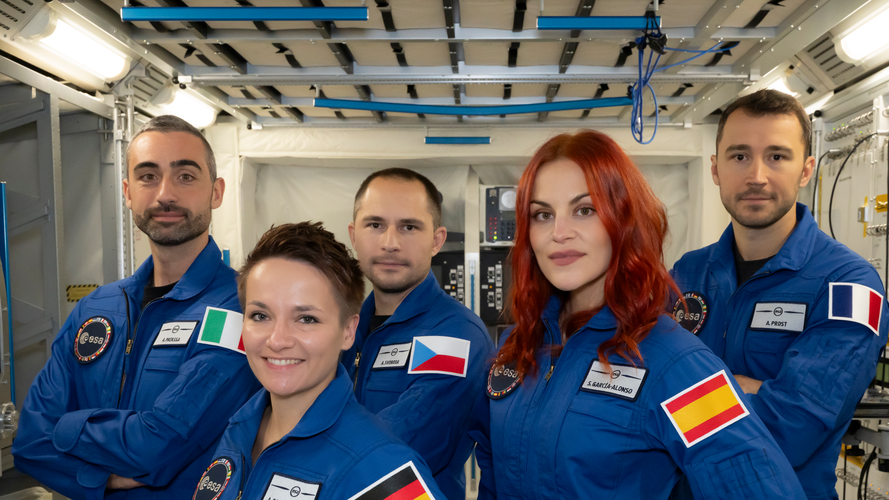
Copernical Team
Top Earth observation stories of 2024

This year has been a whirlwind of fascinating Earth observation stories, from dramatic volcanic eruptions to Saharan dust plumes to epic meteorite craters. Let’s dive into some of the most memorable highlights from 2024.
The ART of training

For the first group of ESA’s Astronaut Reserve, two intensive months of Astronaut Reserve Training (ART) have come to a close. During this initial training phase, members of the ESA Astronaut Reserve Sara García Alonso from Spain, Andrea Patassa from Italy, Arnaud Prost from France, Amelie Schoenenwald from Germany, and Aleš Svoboda from Czechia were introduced to essential skills required for future space exploration and scientific research.
Don’t miss the final ESA Impact of the year!

Don’t miss the final ESA Impact of the year!
Your interactive gateway to the most captivating stories and stunning visuals from ESA.
NASA's Parker Solar Probe aims to fly closer to the sun like never before
This request seems a bit unusual, so we need to confirm that you're human. Please press and hold the button until it turns completely green. Thank you for your cooperation!
Press and hold the button
If you believe this is an error, please contact our support team.
185.132.36.159 : f6afd186-c698-4551-a694-c15ab402
Planet-forming discs persist longer in early Universe environments
 New findings from the NASA/ESA/CSA James Webb Space Telescope challenge our understanding of planet formation by confirming a longstanding puzzle initially uncovered by the Hubble Space Telescope over two decades ago. The discovery highlights that planet-forming discs persisted far longer in the Universe's early days, even in conditions once deemed inhospitable for planet growth.
In 2003,
New findings from the NASA/ESA/CSA James Webb Space Telescope challenge our understanding of planet formation by confirming a longstanding puzzle initially uncovered by the Hubble Space Telescope over two decades ago. The discovery highlights that planet-forming discs persisted far longer in the Universe's early days, even in conditions once deemed inhospitable for planet growth.
In 2003, ALMA observes dust clump where a new planet may form
 The Atacama Large Millimeter/submillimeter Array (ALMA) has uncovered critical details about planetary system formation by detecting a dense concentration of dust grains outside the orbits of two known planets in the protoplanetary disk surrounding the young star PDS 70. These findings, led by Kiyoaki Doi, a researcher at the Max Planck Institute for Astronomy and former Ph.D. student at the Nat
The Atacama Large Millimeter/submillimeter Array (ALMA) has uncovered critical details about planetary system formation by detecting a dense concentration of dust grains outside the orbits of two known planets in the protoplanetary disk surrounding the young star PDS 70. These findings, led by Kiyoaki Doi, a researcher at the Max Planck Institute for Astronomy and former Ph.D. student at the Nat ispace and Magna Petra collaborate on future Lunar resources exploration
 ispace, inc. (ispace) (TOKYO: 9348), a global leader in lunar exploration, and Magna Petra, a pioneering company focused on the extraction and return of helium-3 isotopes from the Moon, have signed a memorandum of understanding to advance sustainable resource exploration on the lunar surface.
The agreement outlines plans for both companies to contribute to the growth of the lunar economy b
ispace, inc. (ispace) (TOKYO: 9348), a global leader in lunar exploration, and Magna Petra, a pioneering company focused on the extraction and return of helium-3 isotopes from the Moon, have signed a memorandum of understanding to advance sustainable resource exploration on the lunar surface.
The agreement outlines plans for both companies to contribute to the growth of the lunar economy b Australia's Lunar rover advances with Swinburne technology at the core
 Swinburne University of Technology has been chosen to provide essential technology for a groundbreaking national mission: Australia's first lunar rover.
As part of the $42 million Australian Space Agency project, the ELO2 Consortium will design, build, and operate the Australian-made rover, "Roo-ver," on the Moon's surface. Swinburne's Space Technology and Industry Institute (STII) will pl
Swinburne University of Technology has been chosen to provide essential technology for a groundbreaking national mission: Australia's first lunar rover.
As part of the $42 million Australian Space Agency project, the ELO2 Consortium will design, build, and operate the Australian-made rover, "Roo-ver," on the Moon's surface. Swinburne's Space Technology and Industry Institute (STII) will pl T-Mobile opens Beta Registration for Starlink Direct-to-Cell Satellite Service
 T-Mobile has launched registration for its beta program of T-Mobile Starlink, a new direct-to-cell satellite service set to eliminate cellular dead zones by covering the 500,000 square miles in the U.S. without ground-based network access. The beta program follows recent FCC approval and marks a key step in integrating Starlink's satellite technology with T-Mobile's terrestrial network.
"T
T-Mobile has launched registration for its beta program of T-Mobile Starlink, a new direct-to-cell satellite service set to eliminate cellular dead zones by covering the 500,000 square miles in the U.S. without ground-based network access. The beta program follows recent FCC approval and marks a key step in integrating Starlink's satellite technology with T-Mobile's terrestrial network.
"T Parker Solar Probe begins record-setting closest approach to the Sun
 NASA's Parker Solar Probe is in good health and operating normally as it speeds toward its closest-ever flight around the Sun on Christmas Eve.
Mission operators at the Johns Hopkins Applied Physics Laboratory (APL) in Laurel, Maryland, received a beacon transmission from Parker, through NASA's Deep Space Network complex in Canberra, Australia, indicating all spacecraft systems were operat
NASA's Parker Solar Probe is in good health and operating normally as it speeds toward its closest-ever flight around the Sun on Christmas Eve.
Mission operators at the Johns Hopkins Applied Physics Laboratory (APL) in Laurel, Maryland, received a beacon transmission from Parker, through NASA's Deep Space Network complex in Canberra, Australia, indicating all spacecraft systems were operat 
